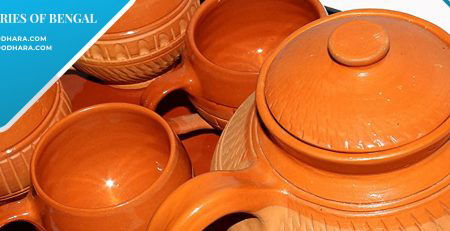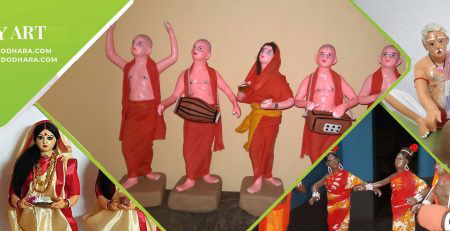Dhokra Art: Magic Crafted By The Metalsmiths Of Bengal
 India’s cultural diversity is highlighted through its various cultures. An example of this is in the country’s handicrafts that have successfully preserved its ancient art forms. Dhokra is one such art form that originates from deep within Bengal. An art so eternal that casts resoluteness in the crafted metal.
India’s cultural diversity is highlighted through its various cultures. An example of this is in the country’s handicrafts that have successfully preserved its ancient art forms. Dhokra is one such art form that originates from deep within Bengal. An art so eternal that casts resoluteness in the crafted metal.
Dhokra art, an ancient method of making metal artefacts, dates back to over 5000 years. This tribal art form, done by the traditional metalsmiths of Bengal – the Dhokra Damar tribes, has surprisingly outlived the test of time and can still be found today. Here’s a peek into this metal art journey, a gift from Bengal to the rest of the world.
What is Dhokra art?
 Dhokra art refers to the stunning metal figurines fashioned from bronze and copper-based alloys using a ‘lost wax casting’, otherwise in French known as ‘cire perdue’. The making of Dhokra art involves several processes, thus making a single piece of creation takes a long time – A month or two.
Dhokra art refers to the stunning metal figurines fashioned from bronze and copper-based alloys using a ‘lost wax casting’, otherwise in French known as ‘cire perdue’. The making of Dhokra art involves several processes, thus making a single piece of creation takes a long time – A month or two.
This nature of casting metal has been observed in India, dating back to 4,000 years and lasting. An example of the earliest found wax artefacts is of a dancing girl of Mohenjo-Daro. The dhokra artisans’ product is in great demand across several markets because of primitive simplicity, enchanting folk motifs and unique form. Popular dhokra items are – elephants, horses, owls, peacocks, religious images etc.
How did Dhokra Art originate?
 The name ‘Dhokra’ arises from the Dhokra Damar tribes residing in West Bengal. They originally began practising this art form. The artwork later spread its roots to other parts of India. Dhokra involves two categories of casting – Hollow & Solid Casting. The hollow casting is seen primarily in Central and Eastern areas, including Chhattisgarh, Madhya Pradesh, Jharkhand and West Bengal. In contrast, solid casting is practised down in the South region.
The name ‘Dhokra’ arises from the Dhokra Damar tribes residing in West Bengal. They originally began practising this art form. The artwork later spread its roots to other parts of India. Dhokra involves two categories of casting – Hollow & Solid Casting. The hollow casting is seen primarily in Central and Eastern areas, including Chhattisgarh, Madhya Pradesh, Jharkhand and West Bengal. In contrast, solid casting is practised down in the South region.
Bell Metal – an alloy of Brass, Nickel & Zinc oxide – is used to craft Dhokra. Despite the artefacts sporting humble inceptions in clay core, they have earned tremendous acclaim globally across in the last few decades of their existence.
Most Dhokra artefacts represent human or animal figurines. The legendary dancing girl of Mohenjo Daro, for example, is one of the earliest known lost wax casting artefacts.
The themes are usually relatively limited since the metalsmiths do not receive much exposure beyond what they observe in their surroundings. The significant part is that the technique once upon a time used only to create articles for the tribesmen’s individual use has now evolved to make jewellery boxes, tableware, and so much more.
A complete finished product involves thirteen processes. A typical Dhokra figurine always has thin hands, legs and a slender body, the beauty of which lies in its imperfection. This technique is dependant on expertise and talent to ensure every step is carried out seamlessly. The mould has to keep its shape until the final stage of the process. The process is undoubtedly elaborate and time-consuming, besides the fact that it requires years of mastery.
Furthermore, a single mould can be used only once, making each finished product is different and unique. The final artefact is completed perfectly only when the artist has mastered the skill of working with clay and metal.
This metal originated form of creation is not just one of the oldest but is also the most advanced in its field. No wonder people are still mesmerized by the picturesque beauty of these handicrafts.
The craft is inspired by the tribal lifestyle, which today translates into everyday decorative objects. Common ones include lamps, combs, cups and bowls. Dhokra Jewellery is also becoming popular in recent times.










Comment (1)
Very good initiative. Looking forward.